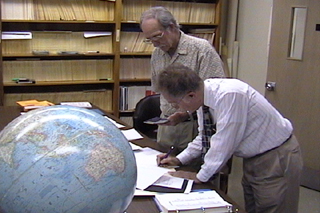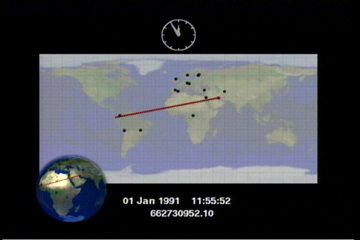Unexplained Sets of Seismographic Station Reports
and
A Set Consistent with a Quark Nugget Passage
David P. Anderson, Eugene T. Herrin, Vigdor L. Teplitz, Ileana M. Tibuleac
Department of Geological Sciences,
Southern Methodist University
This paper is also available from the Los Alamos National Laboratory
Archive Server

ABSTRACT
In 1984 Edward Witten proposed that an extremely dense form of matter composed of up, down, and strange quarks may be stable at zero pressure (Witten, 1984). Massive nuggets of such dense matter, if they exist, may pass through the Earth and be detectable by the seismic signals they generate (de Rujula and Glashow, 1984). With this motivation we investigated over 1 million seismic data reports from the U.S. Geological Survey for the years 1990-1993 not associated with epicentral sources. We report two results: (1) with an average of about 0.16 unassociated reports per minute after data cuts, we find a significant excess over statistical expectation for sets with ten or more reports in ten minutes; and (2) in spite of a very small a priori probability from random reports, we found one set of reports with arrival times and other features appropriate to signals from an epilinear source. This event has the properties predicted for the passage of a nugget of strange quark matter (SQM) through the earth, although there is no direct confirmation from other phenomenologies.
The SQM paper is available in Adobe Acrobat format (368k)
and MicroSoft Word 97 format (1.6M).
The Adobe Acrobat file can be read with the free "pdf" reader available from
Adobe.com.
The paper is 24 pages with 9 figures.
This paper has been accepted for publication in the December 2003
Bulletin of the
Seismological Society of America.
The Monte Carlo simulation
by Herrin and Teplitz on which this work is based is available
from
Physical Review
The extended p-wave seismic travel time table generated for this research,
to depth of 2880 km (the core/mantle boundary) is
available for download
in the form of a table and C source code for reading and interpolating that table.
 Here is an
mpeg animation (360k) of a hypothetical synthetic strike showing the timing expected from a
linear seismic source such as might be produced by an SQN passage through the earth. The
seismic stations nearest the entry and exit points of the line receive the signal first,
followed by the stations along the line, with stations midway along the line reporting last.
Compare this with the radial spreading wavefront pattern of an epicentral seismic source
like this 1992
Chinese Nuclear Blast.
Here is an
mpeg animation (360k) of a hypothetical synthetic strike showing the timing expected from a
linear seismic source such as might be produced by an SQN passage through the earth. The
seismic stations nearest the entry and exit points of the line receive the signal first,
followed by the stations along the line, with stations midway along the line reporting last.
Compare this with the radial spreading wavefront pattern of an epicentral seismic source
like this 1992
Chinese Nuclear Blast.
Additional information is available from
SMU News and Information.
Here are some related materials
and some jpeg and
tiff figures.
SMU Geological Sciences Archive.
SMU Geological Sciences Homepage.
Last update by dpa: 19 December 2003


 Here is an
mpeg animation (360k) of a hypothetical synthetic strike showing the timing expected from a
linear seismic source such as might be produced by an SQN passage through the earth. The
seismic stations nearest the entry and exit points of the line receive the signal first,
followed by the stations along the line, with stations midway along the line reporting last.
Compare this with the radial spreading wavefront pattern of an epicentral seismic source
like this 1992
Chinese Nuclear Blast.
Here is an
mpeg animation (360k) of a hypothetical synthetic strike showing the timing expected from a
linear seismic source such as might be produced by an SQN passage through the earth. The
seismic stations nearest the entry and exit points of the line receive the signal first,
followed by the stations along the line, with stations midway along the line reporting last.
Compare this with the radial spreading wavefront pattern of an epicentral seismic source
like this 1992
Chinese Nuclear Blast.